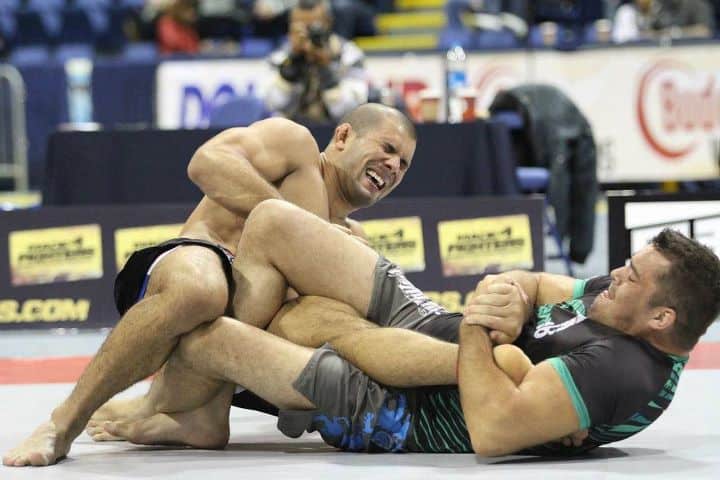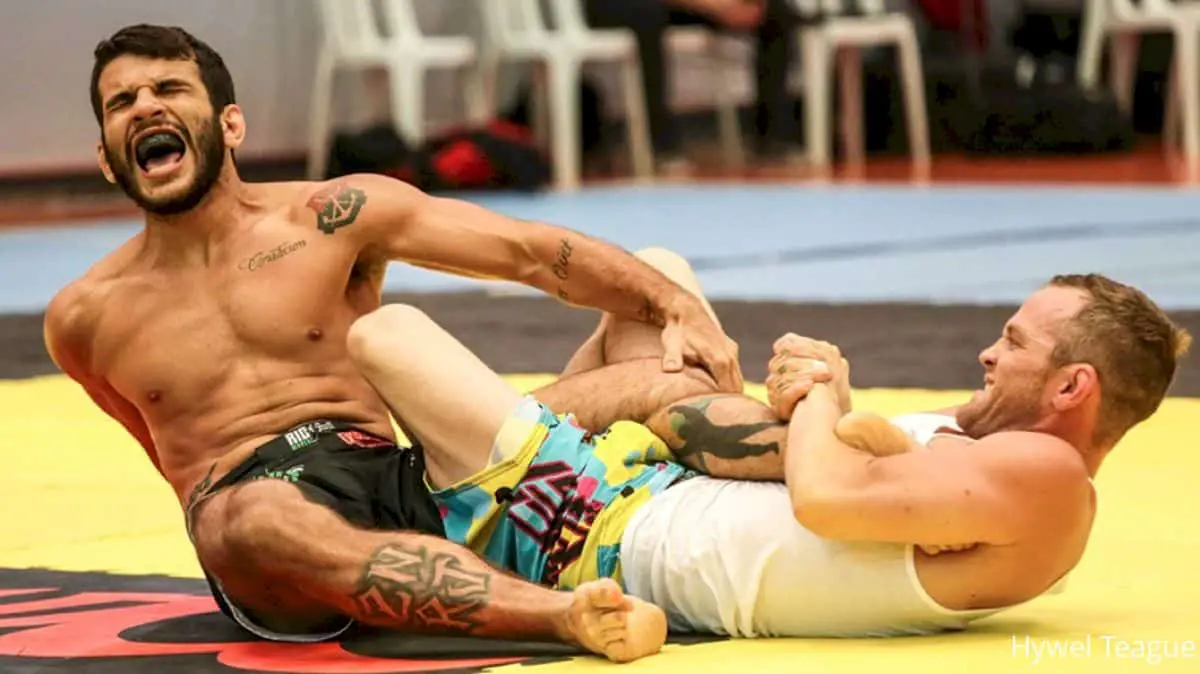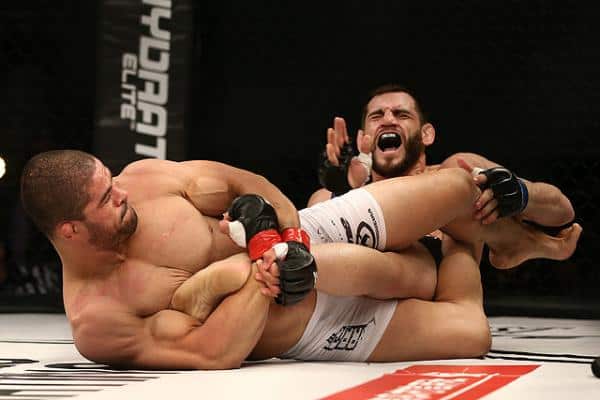Leg locks have been the flavor of the month in BJJ for the last few years. With certain BJJ athletes exploiting the overall general lack of knowledge of leg locks in the BJJ world. Why is there a reluctance by certain BJJ athletes to train and explore leg locks? We will look at exactly why there is a negative attitude towards leg locks.
Why are leg locks frowned upon? Leg locks are frowned upon as they were considered a dirty and cheap tactic that only poor BJJ athletes resorted to. Only a weak BJJ player who couldn’t pass the guard would use leg locks. Leg locks were also considered too dangerous to train and therefore were banned in many gyms and competitions.

History Of Leg Locks In BJJ

Maeda taught the Gracie’s leg locks as they were apart of the original Judo curriculum established by Judo’s founder Kano. You can even find an old picture of Helio attacking a straight ankle lock. So originally the Gracie’s were not against leg locks.
However, in later years the Gracies’ attitude towards leg locks soured. There are different theories on why that is. One theory is that the Gracie’s chose to focus on the guard. The guard was to be the main position in BJJ where an athlete could both defend and attack from.
The Gracie style of BJJ espoused that to attack and submit you had to get past the guard of your opponent. Leg locks disturbed this theory of BJJ as they are allowed you to submit your opponent without having to pass your opponent’s guard. Instead, you could grab a leg and sit back and go for a leg lock. The Gracies and other early BJJ practitioners viewed this as a cheap tactic. Only an unskilled BJJ athlete who wasn’t capable of passing the guard would resort to attacking leg locks. Based on this view leg locks were and continue to be frowned upon by BJJ practitioners.
The other theory is based on BJJ’s rivalry with other Jiu Jitsu schools. The Gracie’s weren’t the only students of Maeda. Maeda also taught Luiz Franca who had a famous student Oswaldo Fadda. In 1955 Oswaldo Fadda challenged the Gracies to a series a matches which pitted his students against the Gracie family.
The results are controversial with a newspaper saying 14 matches took place with 7 wins for the Gracies, 3 wins for Fadda’s team and 4 draws. Another source says Fadda’s team was victorious. What isn’t contested is that Fadda’s team won a number of matches using leg locks which the Gracies were not well versed in.
There is a rumor that after suffering defeat by leg locks the Gracies banned their students from using them and banned them in competitions to prevent other BJJ practitioners from taking advantage of their lack of knowledge. Which ever theory you choose to believe there is no doubt that the Gracies early dislike of leg locks has continued to influence generations of BJJ athletes as leg locks continue to be derided in the BJJ community.
Are Leg Locks Dangerous?

Are leg locks dangerous? Certain leg locks such as the inside heel hook and toe hold are dangerous as they give opponents very little time to tap before breakage occurs. The majority of leg locks such as knee bars and straight ankle locks are safe as opponents have plenty of time to tap before injury occurs.
There are currently two opposing views in the BJJ world about leg locks. One camp says they are perfectly safe and are no different to any other submission and the other camp says they are incredibly dangerous and just thinking about a leg lock can cause an injury. Like with most things in life they are both partly right.
The majority of leg locks are safe to train as it is difficult to break your opponents leg with the lock and your opponent has plenty of time to tap before the break happens. Straight ankle locks and knee bars fall into this category. Even the IBJJF recognizes this and even allows white belts to attack straight ankle locks in competition.
Knee bars are a little more dangerous as it is easier to damage the knee with this submission however, usually an athlete will be able to tap before injury occurs. This is why the IBJJF allows brown belts to attack with knee bars.
Now where the anti leg lock crowd is correct about leg locks is when they refer to the inside heel hook. The inside heel hook places an enormous about of stress on the ligaments in the knee and if you do not tap quickly to the submission there is a very likely chance that your ligaments will be torn.
An inside heel hook is where you have your opponents leg draped across your body whereas an outside heel hook is where you have your opponent’s leg outside your body. Both are dangerous submissions but it is much harder to break an opponent’s leg with an outside heel hook which gives an opponent more time to tap before an injury occurs.
Even the Danaher Death Squad who are the masters of inside heel hooks admit that they regularly take pops in training when they are defending against inside heel hooks. As the submission comes on so quickly that you often don’t have time to tap or the injury comes out of nowhere. One second an athlete may feel no pain, then a second later their ankle might be making loud scary sounds.
In competitions that allow inside heel hooks you will often see competitors cry out in pain and get up hobbling after being caught in an inside heel hook. Fortunately, with an inside heel hook the ligaments in the ankle usually get stretched and torn before the knee so athletes usually have time to tap to save their knees. Some athletes are stubborn and refuse to tap and end up with torn MCLs or ACLs.
Interestingly, when Craig Jones (leg lock extraordinaire and Danaher Death Squad) took on Vinny Magalhaes, a high level black belt who is known for refusing to tap to heel hooks due to his incredibly strong knee ligaments and flexible ankles, it wasn’t Magalhaes’ ligaments that tore when Jones cranked a tight heel hook but it was actually his Tibia that broke.
It appears the heel hook will attack your body where you are the weakest, if your ankles are too strong, it will go for your knee and if your knee is too strong it will eventually come for the bones in your leg.
Here Is Craig Jones Breaking Vinny Magalhaes’ Leg With A Heel Hook
Do Leg Locks Work In MMA?

Do leg locks work in MMA? Leg locks do work in MMA. However, leg locks can expose an MMA fighter to ground strikes as an athlete will often have to used both arms to secure the leg and finish the submission. There are very few MMA fighters who are well versed in leg locks so they are rare however, Gary Tonon, Ryan Hall and Palhares have used them successfully in MMA.
Many early BJJ practitioners were training to compete in Vale Tudo, No Holds Barred and MMA competitions. These early BJJ practitioners were convinced that attacking leg locks which result in them being knocked out as it exposed their face to ground strikes. This belief further added to the negative view that BJJ athletes had about leg locks.
Even though leg locks can be dangerous in MMA, modern MMA athletes such as Ryan Hall have shown that you can successfully attack and finish leg locks without taking damage. He has shown that when done correctly a leg lock will put you in a position where your opponent can not hit you and that it only takes a few seconds to finish a leg lock making it a highly effective way to win a fight.
Here Is Ryan Hall Effortlessly Leg Locking MMA Legend BJ Penn
Conclusion
Leg locks are frowned upon due to the belief that they are a cheap trick used by unskilled BJJ athletes who do not have the technique required to pass an opponent’s guard. There is also a common belief that leg locks are too dangerous to train and that they should be banned.
In recent years the attitudes about leg locks are shifting as certain BJJ athletes have taken advantage of the overall low leg locking skill of many BJJ athletes. In the modern era of BJJ if you want to be successful you need to understand leg locks especially now heel hooks are legal in IBJJF tournaments.
